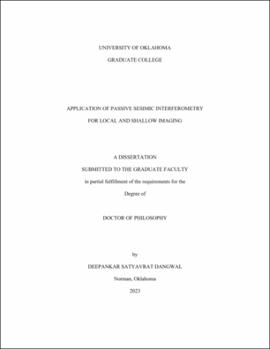| dc.description.abstract | Exploratory imaging of the shallow crust is motivated by – (i) the presence of exploitable natural resources, (ii) its influence on seismicity and associated hazards, and (iii) the insights it can provide into the evolution of geological landforms. Keeping in mind these motivations, I use passive seismic interferometry to image the shallow crustal structures. Conventional exploration seismology focuses on local scale imaging using active-source methods (e.g., dynamite, air guns, vibro-seis). In contrast, passive seismic interferometry offers the possibility to use universally available noise sources (both natural and anthropogenic) for subsurface imaging. This approach does not require a spatially and temporally confined seismic source and is thus a cost-effective alternative in logistically challenging environments (e.g., polar ice sheets, exo-planets, etc.). Further, the use of ambient noise as a seismic source minimizes the adverse environmental impact of explosive source experiments in sensitive ecological zones.
Ambient noise methods generally utilize low-frequency diffuse noise fields (e.g., microseisms) for global scale imaging of deep earth structures. Application of these methods at shallow scales is challenged by the scarcity of high-frequency ambient noise sources in local settings. Areas away from anthropological activity have very weak noise sources of sufficiently high frequencies. Although, in urban environments some high-frequency sources are available (e.g., traffic, industrial noise), but these are usually confined to a narrow azimuth. Moreover, local noise sources predominantly produce surface waves which have limited vertical and horizontal resolution to be able to image the shallow subsurface.
In this dissertation, I focus on the applications of passive seismic interferometry for high-resolution imaging of the shallow subsurface (<1 km depth) by attempting to overcome the challenges and limitations mentioned above. Three diverse application scenarios are presented to demonstrate the versatility of the interferometric methods. These include – (i) Passive P- and S-wave reflectivity imaging in an oil field (Wellington, Kansas) setting using reservoir monitoring data; (ii) Passive seismic imaging of a buried alpine valley (Unaweep, Colorado) to test the hypothesis of Paleozoic glaciation; (iii) Passive seismic imaging for seismic hazard assessment in an urban environment (Enid, Oklahoma).
Reflectivity imaging using passive seismic interferometry is generally challenged by the dominance of surface-waves in ambient noise recordings. To overcome this limitation, I develop and implement single-station polarization filters to automatically extract body waves (P- and S-waves) from continuous ambient noise. The extracted waves are then subjected to interferometric processing to retrieve subsurface reflections. This methodology is suitable for sparse and irregular seismic networks such as the previously mentioned reservoir monitoring array. In another application, similar results are achieved by using a teleseismic catalog to extract the P-wave coda.
Road-side deployments in the alpine valley and the urban environment mentioned above make linear array geometry feasible. I take advantage of the linear geometry to interferometrically retrieve surface waves propagating along the array which are then inverted to obtain a shear-velocity profile. I compliment the shear-velocity models with results from other passive seismic methods – e.g., structural reflectivity from teleseismic coda-wave autocorrelation, or layer thickness from horizontal-to-vertical spectral ratio analysis.
The main results presented in this dissertation includes the retrieval of shallow (< 1 km) structural reflections and the estimation of seismic speed ratio (Vp/Vs) at the Wellington Oil field. This is significant since very few studies have reported the retrieval of S-wave reflectivity using passive seismic methods. In the Unaweep canyon, I image the buried valley floor. The undulating sedimentary-basement interface revealed by the passive imaging suggests the glacial genesis of the canyon. In the Enid study, the high lateral resolution near surface model is well correlated with the site amplification data derived from distributed acoustic sensing. In an urban environment, such experiments are relevant for town-planning and can be used to assess the seismic hazard at sub-kilometer scales. | en_US |

